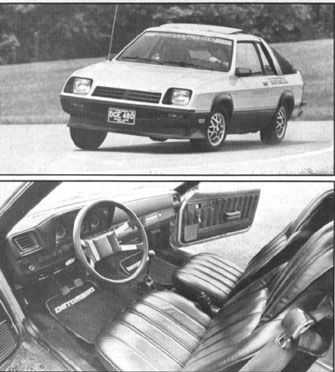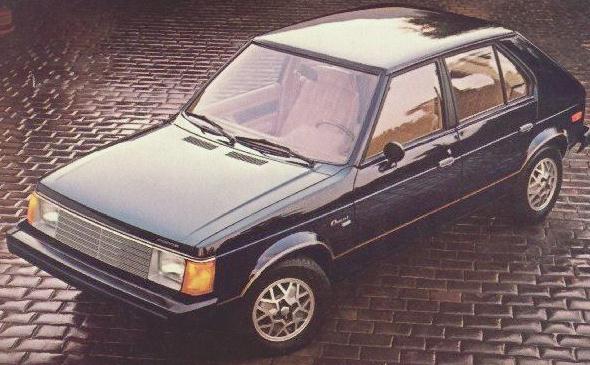Special L-body packages and models
The L-body cars that tend to interest Team Omni members are, naturally, the rare packages and the high-performance models. This page will describe each of these packages and/or vehicles except for the well-documented Dodge Shelby Charger and Dodge Omni GLH. Note that there were often significant changes from one year to the next; things could get a bit confusing. I will endeavor to explain things as clearly as possible.
Dodge Omni 024 DeTomaso
 |
The DeTomaso package was introduced for the 1980 model year. Applied only to the two-door 024, the DeTomaso package was available only in Graphic Red or Bright Yellow colors. Its equipment list featured black trim and accents, front air dam, wheel well flares, vertical rear window louvers, rear spoiler, cast aluminum wheels wearing 185/70-13 tires, a bright brushed transverse roof band, DeTomaso decals on the bodyside, spoiler, and windshield, black bucket seats, Rallye instrument cluster, leather wrapped steering wheel and shift knob, floormats with the DeTomaso logo, a special dash plaque, and sport suspension. A 4-speed manual transmission was standard, mated to the 1.7L engine (the only powerplant available). 1,333 were produced this year.
For 1981, the DeTomaso package was changed slightly. It now included 14" wheels and the new 2.2 liter engine; a new primary color (silver) was made available. Otherwise, it was the same as before. Production was 619 units. This was the last year of the DeTomaso package.
|
Dodge Omni Euro-Sedan

Introduced for the 1981 model year (shown above), this was a special package for the 4-door Omni. Coded A69, it featured black trim, 175/75-13 tires on cast aluminum wheels, the Sport interior with corded cloth bucket seats, Rallye instrument cluster, a 4-spoke steering wheel, and carpeted cargo area. Only 557 were produced.
The Omni Euro-Sedan became a seperate model for 1982. It now featured black trim, dual black remote mirrors, bumper rub strips, special bodyside and mirror stripes, the Rallye instrument cluster, a shift lever console, and high-back cloth & vinly bucket seats with recliners. Only 639 were produced, and this was the last year the Euro-Sedan was available.
Dodge Charger 2.2
Introduced as a special option during the 1981 model year, the Charger 2.2 was a new sports coupe theme. Coded A54, the package included a simulated hood scoop and front fender exhausters, rear quarter window appliques, rear spoiler, 195/60-14 tires on steel Rallye wheels, 'Charger 2.2' tape graphics, and a 4-speed manual transmission with 3.13:1 gear ratio. An automatic was available, if desired; its ratio was 2.71:1. Production was 7,306 cars.
For 1982, the Charger 2.2 became a seperate model. It was available in five colors: Black, Graphic Red, Pearl White, Burnished Silver metallic, and Ensign Blue metallic. 14,420 were made.
The model was mostly carry-over for 1983, however, the standard transmission was upgraded to the newly available 5-speed. An automatic was still optional for the shiftless crowd. 10,448 were produced - 7,433 manuals and 3,015 automatics.
The model was visually toned down a bit for 1984; the hood scoop and fender exhaust vents disappeared. The unique 'Charger 2.2' tape graphics continued, though. The standard engine continued to be the normal-duty 2.2 liter, but the Shelby's HO 2.2 was optional for a limited time. Note that selecting the HO engine required a 5-speed tranny; if you wanted an automatic you were relegated to the normal 2.2. This year 11,949 were produced - 504 with the HO engine, 6,854 with a manual and the standard engine, and 4,591 automatics.
For 1985, the HO engine was now standard equipment if you wanted a 5-speed. The lesser 2.2 was only available with an automatic. Production totalled 10,645 - 6,428 with the HO engine and 4,217 automatics.
The Charger 2.2 was unchanged for 1986, which would be the last year for this model. Only 4,814 were produced - 3,153 with the HO engine and 1,661 automatics.
Plymouth Horizon Euro-Sedan
Like Dodge, Plymouth introduced a Euro-Sedan package for its 4-door model in 1981. Also coded A69, the Plymouth version included black trim and mouldings, 175/75-13 tires on cast aluminum wheels, new bodyside stripes, the Rallye instrument cluster, a 4-spoke steering wheel, cloth & vinyl bucket seats, and a stiffer supension. Exact production in unknown.
Also like Dodge, the Plymouth Euro-Sedan became a seperate Horizon model for 1982. It now included the Rallye instrument cluster, high-back cloth & vinyl bucket seats, shift console, black mouldings, black upper door frames and B-pillar paint, dual black remote mirrors with tape stripes, black door handle inserts, black bumpers with protective strips, tape stripes from the front to rear wheel openings, and a 4-speed transmission with 3.13:1 axle ratio. The 1.7L engine was standard, but the 2.2L was optional (except in California, where the 2.2L was standard). Production for 1982 was 779 units. Like Dodge, Plymouth discontinued the Euro-Sedan after this year.
Plymouth Horizon TC3 Turismo
The Turismo name debuted in 1980 as an appearance package for the Horizon TC3. It included cast aluminum wheels, rear spoiler, black mouldings, low-back premium bucket seats, and bright monochrome paint. Production was 1,701 units.
For 1981 the Turismo package was expanded somewhat. It now included 195/60-14s on steel Rallye wheels, sport bucket seats, the Rallye instrument cluster, a 4-spoke steering wheel, bodyside and rear spoiler decals, front fascia and wheel opening stripes, black trim, moulding, and bumper strips, and dual remote sport mirrors. The Turismo now had no TC3 identification, no sill moulding or wheel well moulding. For 1981, all TC3s dropped the Horizon in their name, so this package was now known only as the Plymouth Turismo. Exact production for this year is unknown; the Turismo would become a seperate model for 1982 and all 2-door Horizons would be called Turismos for 1983 and beyond. Hence this is the last year of the Turismo package.
Plymouth Turismo 2.2
For 1982 the Turismo had become a seperate model. However, there was a new Turismo option package: the Turismo 2.2. Besides the 2.2 engine, it included special graphics and two-color striping, hood scoop, rear spoiler, dual remote sport mirrors, 195/60-14 tires on steel Rallye wheels, sport suspension (heavy duty shocks/struts and rear swaybar), and performance exhaust system. The four speed manual was standard and an automatic was optional, as in the Dodge Charger 2.2. Colors were limited to Morocco Red, Charcoal Grey metallic, Burnished Silver metallic, Black, and Pearl White. Production was 3,208 units.
For 1983, the Turismo 2.2 became a seperate model and was now a virtual twin to the Charger 2.2. It also used the newly introduced 5-speed transmission; the old 4-speed was no longer offered with this model. Production was 9,538 units.
For 1984, the Turismo 2.2 model paralleled the Charger 2.2. The hood scoop disappeared, and the HO engine was available for a limited time (and it required a 5-speed transmission). 10,881 were produced.
For 1985, the HO engine was now standard equipment if you wanted a 5-speed. The lesser 2.2 was only available with an automatic. Production totalled 7,785.
The Turismo 2.2 was unchanged for 1986, which would be the last year for this model. Only 4,488 were produced.
Plymouth Duster
Introduced in 1984, the Duster package was available only on base model Turismos. It was basically just an appearance package; it included the rear spoiler, tape stripes, high-back bucket seats, 13" Rallye wheels, and Duster decals. Production was 8,060 units.
The Duster package was complete carry-over for 1985. 27,444 were made.
Again, the Duster package was carry-over for 1986. This would be the last year for the package; 16,987 were produced.
Last modified: 4-30-03. Original page content created by Dempsey Bowling.

